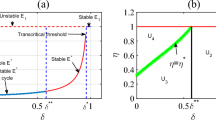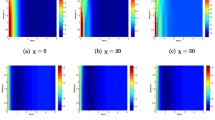Abstract
We formulate and concern a diffusive delayed predator–prey system with herd behavior and fear effect; an Allee effect term and prey chemotaxis are both considered. We first investigate the stability of the system under the strong Allee effect and weak Allee effect without spatial diffusion or time delay. For the spatiotemporal system, the constant positive steady states and semi-trivial steady states are presented. Then, the dynamic behaviors of the diffusive system are demonstrated in detail, and the conditions of Turing instability caused by prey chemotaxis are explored. In addition, we regard the time delay as a bifurcation parameter to investigate the stability of reaction–diffusion system. The normal form theory and center manifold theorem are applied to derive the properties of Hopf bifurcation of the delayed diffusive system. Finally, series of computer simulations are given to verify the theoretical analysis and show how fear effect affects the stability of system.











Similar content being viewed by others
Data availability statement
Data sharing is not applicable to this article as no datasets were generated or analyzed during the current study.
References
Chen, S.S., Lou, Y., Wei, J.J.: Hopf bifurcation in a delayed reaction-diffusion-advection population model. J. Differ. Equations 264(8), 5333–5359 (2018)
Billingham, J.: Dynamics of a strongly nonlocal reaction-diffusion population model. Nonlinearity 17(1), 313–346 (2004)
Wang, M.X.: Stability and Hopf bifurcation for a predator-prey model with prey-stage structure and diffusion. Math. Biosci. 212, 149–160 (2008)
Du, Y.H., Shi, J.P.: A diffusive predator-prey model with a protection zone. J. Differ. Equations 229, 63–91 (2006)
Holzer, M., Popovic, N.: Wavetrain solutions of a reaction-diffusion-advection model of mussel-algae interaction. Siam J. Appl. Dyn. Syst. 16(1), 431–478 (2017)
Sasmal, S.K., Takeuchi, Y.: Modeling the Allee effects induced by cost of predation fear and its carry-over effects. J. Math Anal. Appl. 505, 125485 (2022)
Jiang, H.P., Tang, X.S.: Hopf bifurcation in a diffusive predator-prey model with herd behavior and prey harvesting. J. Appl. Anal. Comput. 9(2), 671–690 (2019)
Li, Y., Wang, M.X.: Hopf bifurcation and global stability of a delayed predator-prey model with prey harvesting. Comput. Math. Appl. 69, 398–410 (2015)
Song, Y.L., Jiang, H.P., Liu, Q.X., Yuan, Y.: Spatiotemporal dynamics of the diffusive mussel-algae model near Turing-Hopf bifurcation. Siam J. Appl. Dyn. Syst. 16(4), 2030–2062 (2017)
Yang, R.Z., Wei, J.J.: Stability and bifurcation analysis of a diffusive prey-predator system in Holling type III with a prey refuge. Nonlinear Dyn. 79, 631–646 (2015)
Zhang, T.H., Xing, Y.P., Zang, H., Han, M.A.: Spatio-temporal dynamics of a reaction-diffusion system for a predator-prey model with hyperbolic mortality. Nonlinear Dyn. 78, 265–277 (2014)
Yang, J.G., Yuan, S.L., Zhang, T.H.: Complex dynamics of a predator-prey system with herd and schooling behavior: with or without delay and diffusion. Nonlinear Dyn. 104, 1709–1735 (2021)
Kooij R., Zegeling, A.: Co-existence of a period annulus and a limit cycle in a class of predator-prey models with group defense. Int. J. Bifurcat. Chaos 31(10), 2021 2150154 (2021)
Mishra, P., Raw, S.N., Tiwari, B.: On a cannibalistic predator-prey model with prey defense and diffusion. Appl. Math. Model. 90, 165–190 (2021)
Meng, X.Y., Wang, J.G.: Dynamical analysis of a delayed diffusive predator-prey model with schooling behaviour and Allee effect. J. Biol. Dynam. 14(1), 826–848 (2020)
Tang, X.S., Song, Y.L.: Stability, Hopf bifurcations and spatial patterns in a delayed diffusive predator-prey model with herd behavior. Appl. Math. Comput. 254, 375–391 (2015)
Qi, H.K., Meng, X.Z.: Threshold behavior of a stochastic predator-prey system with prey refuge and fear effect. Appl. Math. Lett. 113, 106846 (2021)
Cong, P.P., Fan, M., Zou. X.F.: Dynamics of a three-species food chain model with fear effect. Commun Nonlinear Sci. 99, 105809 (2021)
Liu, Q., Jiang, D.Q.: Influence of the fear factor on the dynamics of a stochastic predator-prey model. Appl. Math. Lett. 112, 106756 (2021)
Liu, Y.Y., Wei. J.J.: Double Hopf bifurcation of a diffusive predator-prey system with strong Allee effect and two delays. Nonlinear Anal-Model. 26, 72-92 (2021)
Shi, J.P., Shivaji, R.: Persistence in reaction diffusion models with weak allee effect. J. Math Biol. 52, 807–829 (2006)
Wang, J.F., Shi, J.P., Wei, J.J.: Predator-prey system with strong Allee effect in prey. J. Math. Biol. 62, 291–331 (2011)
Sen, D., Ghorai, S., Sharma, S., Banerjee, M.: Allee effect in prey’s growth reduces the dynamical complexity in prey-predator model with generalist predator. Appl. Math. Model. 91, 768–790 (2021)
Tao, X.Y., Zhu, L.H.: Study of periodic diffusion and time delay induced spatiotemporal patterns in a predator-prey system. Chaos Solution. Fract. 150, 111101 (2021)
Ruan, S.G., Wei, J.J.: On the zeros of transcendental functions with applications to stability of delay differential equations with two delays. Dyn. Contin. Discrete Impuls. Syst. Ser. A Math. Anal. 10, 863-874 (2003)
Song, Y.L., Peng, Y.H., Zou, X.F.: Persistence, stability and hopf bifurcation in a diffusive ratio-dependent predator-prey model with delay. Int. J. Bifur. Chaos 24(07), 1450093 (2014)
Zuo, W.J., Wei, J.J.: Stability and hopf bifurcation in a diffusive predator-prey system with delay effect. Nonlinear Anal. Real World Appl. 12(4), 1998–2011 (2011)
Li, F., Zhang, S.Q., Meng, X.Z.: Dynamics analysis and numerical simulations of a delayed stochastic epidemic model subject to a general response function. Comput. Appl. Math. 38, 95 (2019)
Stepan, G.: Great delay in a predator-prey model. Nonlinear Anal. Theor. 10(9), 913–929 (1986)
Zhong, F.Y., Xu, Z.C., Ge, B.: Hopf bifurcation analysis of a class of abstract delay differential equation. 4(2), 277C29 (2022)
Li, D., He, X.L., Li, X.P., Guo, S.J.: Traveling wavefronts in a two-species chemotaxis model with Lotka-Volterra competitive kinetics. Appl. Math. Lett. 114, 106905 (2021)
Lin, C.S., Ni, W.M., Takagi, I.: Large amplitude stationary solutions to a chemotaxis system. J. Differ. Equ. 72(1), 1–27 (1988)
Dai, B.X., Sun, G.X.: Turing-Hopf bifurcation of a delayed diffusive predator-prey system with chemotaxis and fear effect. Appl. Math. Lett. 111, 106644 (2021)
Lou, Y., Ni, W.M.: Diffusion, self-diffusion cross-diffusion. J. Differ. Equ. 131(1), 79–131 (1996)
Shi, Y., Wu, J.H., Cao, Q.: Analysis on a diffusive multiple Allee effects predator-prey model induced by fear factors. Nonlinear Anal. Real. 59, 103249 (2021)
Hassard, B.D., Kazarinoff, N.D., Wan, Y.H.: Theory and applications of Hopf bifurcation. Cambridge University Press, Cambridge (1981)
Faria, T.: Normal forms and hopf bifurcation for partial differential equations with delays. Trans. Am. Math. Soc. 352(5), 2217–2238 (2000)
Yang, K.: Delay differential equations with applications in population dynamics. Academic Press, Boston (1993)
Wu, J.: Theory and applications of partial functional differential equations. Springer, New York (1996)
Wiggins, S.: Introduction to applied nonlinear dynamical systems and chaos. Springer-Verlag, New York (2003)
Cui, R., Shi, J.P., Wu, B.Y.: Strong Allee effect in a diffusive predator-prey system with a protection zone. J. Differ. Equ. 256(1), 108–129 (2014)
Acknowledgements
This study was funded by the SDUST Research Fund (No. 2014TDJH102), the Research Fund for the Taishan Scholar Project of Shandong Province of China, Shandong Provincial Natural Science Foundation of China (No. ZR2019MA003), and the SDUST Innovation Fund for Graduate Students (YC20210217).
Author information
Authors and Affiliations
Corresponding author
Ethics declarations
Conflicts of interest
The authors declare that they have no conflict of interest.
Additional information
Publisher's Note
Springer Nature remains neutral with regard to jurisdictional claims in published maps and institutional affiliations.
Appendix: Proof for Theorem 4.3
Appendix: Proof for Theorem 4.3
Here, we calculate relevant conditions for some properties of Hopf bifurcations for system (4), and we will apply the normal formal theory and center manifold theorem of PDEs which can be studied in detail in ( [36, 37]). In a general way, let \(j\in N_{0}\), \(\tau _{*}=\tau _{n}^{j}\), \(n\in \{0,1,2\cdot \cdot \cdot N_{2}\}\). Now, we present a new coefficient \(\varsigma \in R\), let \(\tau =\varsigma +\tau _{*}\) such that \(\varsigma =0\) becomes the Hopf bifurcation value. Denote \({\tilde{u}}(\cdot , t)=u(\cdot , \tau t)-u_{*}\), \({\tilde{v}}(\cdot , t)=v(\cdot , \tau t)-v_{*}\), \({\tilde{U}}(t)=({\tilde{u}}(\cdot , \tau t), {\tilde{v}}(\cdot , \tau t))\). Based on the above, we know Eq. 23) has two simply purely imaginary roots which can be written as \(\pm i\omega _{*}\).
For simplicity of the notation, then dropping the tildes, rewriting system (4) as:
with
where
Applying the Riesz representation theorem [38], \(\eta (\theta ,\tau _{*})\) \((\theta \in [-1,0])\) is a \(2\times 2\) matrix function, such that
\(\eta (\theta ,\tau _{*})\)
with
Denote \(\Upsilon (\theta )\in C^{1}([-1,0],R^{2})\), define
And For \(\Psi (\vartheta )\in C^{1}([-1,0],R^{2})\), define
\(\mathcal {C^{*}}\) is the formal adjoint of \({\mathcal {C}}\) under the bilinear pairing
As mentioned above \(\pm i\omega _{*}\) are the eigenvalues of the operator \({\mathcal {C}}\) , thus, it is easy to get the \(\pm i\omega _{*}\) are also the eigenvalues of \(\mathcal {C^{*}}\).
Suppose that \(P(\theta )=(P_{1},P_{2})^\mathrm {T}e^{i\omega _{*}\tau _{*}\theta }=(1,P_{2})^\mathrm {T}e^{i\omega _{*}\tau _{*}\theta }\), \(\theta \in [-1,0]\) is the eigenvector of \({\mathcal {C}}\), \(i\omega _{*}\tau _{*}\) is the root of \({\mathcal {C}}\), and \(Q(\vartheta )=R(Q_{1},Q_{2})^\mathrm {T}e^{i\omega _{*}\tau _{*}\vartheta }=R(1,Q_{2})^\mathrm {T}e^{i\omega _{*}\tau _{*}\vartheta }\) is the eigenvector of \(\mathcal {C^{*}}\), \(-i\omega _{*}\tau _{*}\) is the root of \(\mathcal {C^{*}}\). Refer to [39] for detailed methods and definitions. According to the equation \(\langle P^{*}(\theta ),Q(\vartheta )\rangle =1\), then we obtain
Thus, we can compute \(f^{(2)}_{100}=0,\) then we have
Through the calculation above, we have
Therefore, we can compute the following quantities \(g_{20}=\tau _{*}{\bar{R}}\left[ f_{20}^{(1)}+2f_{11}^{(1)}P_{2}+f_{02}^{(1)}P_{2}^{2}\right. \) \(\qquad \,\,\left. +\bar{Q_{2}}\left( f_{002}^{(2)}e^{-2i\omega \tau _{*}}+2f_{011}\right) e^{-i\omega \tau _{*}}P_{2}\right] ,\) \(g_{11}=\tau _{*}{\bar{R}}\left[ f_{20}^{(1)}+f_{02}^{(1)}P_{2}{\bar{P}}_{2}+2f_{11}^{(1)}Re\{P_{2}\}+{\bar{Q}}_{2}\right. \) \(\qquad \,\,\left. \left( f_{002}+2f_{011}Re\{P_{2}\}\right) e^{-i\omega \tau _{*}}\right] ,\) \(g_{02}={\bar{g}}_{20},\)
where \(n=0,1,2,\cdot \cdot \cdot ,\) then we have
the definition of \(f_{n}\) has the same meaning as in reference [39].
According to the [39], we get
where
Furthermore, we can determine \(g_{21}\) by determining the \(w_{20}\) and \(w_{11}\).
Based on the above analysis, we have [40]
From the above calculation, correlational properties of the Hopf bifurcation according to the sign of \(\mu _{2}\), \(\gamma _{2}\), \(T_{2}\) and \(c_{1}(\tau _{*})\) can be obtained.
Rights and permissions
About this article
Cite this article
Ma, T., Meng, X., Hayat, T. et al. Hopf bifurcation induced by time delay and influence of Allee effect in a diffusive predator–prey system with herd behavior and prey chemotaxis. Nonlinear Dyn 108, 4581–4598 (2022). https://doi.org/10.1007/s11071-022-07401-x
Received:
Accepted:
Published:
Issue Date:
DOI: https://doi.org/10.1007/s11071-022-07401-x




